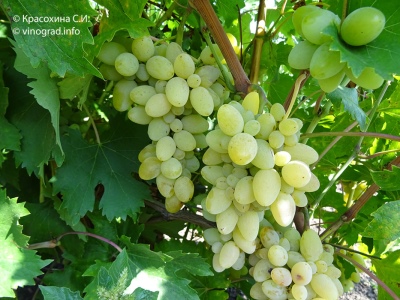
- Authors: Institute of Viticulture "Vierul", Moldova
- Appointment: dining room
- Berry color: yellow-green
- Taste: resembles the Chaush grape variety
- Ripening period: average
- Frost resistance, ° C: -22
- Bunch weight, g: 295
- Yield: 190 c / ha
- Flower type: bisexual
- Tasting assessment, points: 8,1
Grape berries are tasty and rich in various vitamins fruits, which many are happy to grow on their plots. A huge variety of species, which is constantly replenished with new breeding masterpieces, allows each gardener to choose the most suitable variety according to personal preferences and climatic features of the planting region. This article will focus on Liang grapes.
Breeding history
The unpretentious and tasty Liana grape variety was bred in the 70s of the twentieth century in the Scientific and Production Association "Vierul" by a group of Moldovan breeders. The initial varieties for its production were Pierril and Chaush white. From Moldova, Lana's seedlings began to spread to other countries in the 1980s. The cultivation of the new variety has shown itself well in the conditions of the vineyards of the Lower Don region.
Description
A complex hybrid created on the basis of European and American varieties, it successfully combines excellent taste and unpretentiousness in providing care for it. The Liang grape is one of the finest white table grapes. But attempts to create a factory wine in the 1980s from the juice of these grapes were also successful due to the soft and aromatic qualities of the drink. The variety is distinguished by its hardiness, frost resistance and easily tolerates dry years. The bushes grow rapidly and create a strong vine with rounded, light green leaves.
Ripening period
Lyana belongs to the varieties with an average ripening period. The time from the beginning of blooming of the first leaves on the shoots to the collection of ripe berries is about 130 days. In central Russia, it will fully mature by mid-September.
Bunches
In Liang grapes, the size of the bunches is 12x16 cm. The conical shape with branched stalks is filled with berries with an average degree of friability. One bunch can weigh up to 295 grams
Berries
Table berries have a thin skin and fleshy flesh. As befits a hybrid, the presence of seeds inside the berry is minimal, sometimes up to one. Lyana produces a crop of rather large, oval berries, each of which grows up to 2.5 cm long and weighing up to 4 grams. The color of the fruits is light green, in some places with a brownish bloom.
Taste
From its genetic progenitor Chaush, the white Liang variety inherited a pleasant aromatic taste with nutmeg notes. This grape attracts with its juiciness, balance of sweetness and sourness. Tasters rate Lana's harmonious taste at 8.1 points on a 10-point scale.
Yield
On each shoot of a developed Liang grape bush, full ripening from 1 to 2 bunches is possible. From one adult bush, subject to agrotechnical conditions, up to 6 kg of the crop can be harvested. With the industrial cultivation of grapes, it is possible to collect up to 190 centners per hectare.


Growing features
White grapes prefer light soils consisting of loamy or sandy loamy mixtures. In too long periods of drought, bushes can shed individual inflorescences, which, of course, affects yields. The variety does not need chemical protection from many pests and diseases, and due to its ease of care, it is suitable even for the first experiments of novice winegrowers. The versatile characteristics of Lyana make it possible to grow this grape in various regions of Russia, even with low average temperatures.
Landing
For planting seedlings of Liang grapes, slopes well-lit by the sun are chosen. It is necessary to check the depth of the groundwater table, since almost the only health problems of these bushes can cause their close location and stagnation of moisture in the area of the root system. The grafted seedlings are planted in prepared pits, where a small layer of humus-enriched soil has been previously laid.

Pollination
Liang grapes, like many hybrid varieties, have a hermaphroditic or bisexual type of flowers and are self-pollinated species. With prolonged drought during the flowering period, some of the ovaries may crumble.
Pruning
Experts recommend leaving 3 to 6 buds on young shoots in spring, so as not to overload the plant and collect full-fledged berries. During a routine inspection of the bushes, diseased and dry trunks are removed, processing the cut sites with garden pitch.



Frost resistance and the need for shelter
In regions with heavy snowfalls, Liang bushes do not require shelter for the winter. They are resistant to frost and tolerate temperatures as low as –25 degrees.

Diseases and pests
The hybrid was created as resistant to most typical diseases. It does not need prophylactic spraying with chemical means of protection against diseases and pests, traditional for other varieties. The main problem with this variety is the development of bacterial cancerous growths on the branches, which can appear from excess moisture. They get rid of them by removing the affected areas, followed by treatment with a disinfection composition.

If a grape is exposed to any disease or insect, this always affects its appearance.
Storage
The versatile variety can be consumed as fresh berries, juices, wine and preserves. The bunches are distinguished by good keeping quality in cool storages, they are well transported in boxes and retain their presentation for a long time.
The grape, which has received a high tasting rating and has established itself among gardeners as a problem-free variety, allows you to have stable yields every year, reacting little to weather conditions.











































































